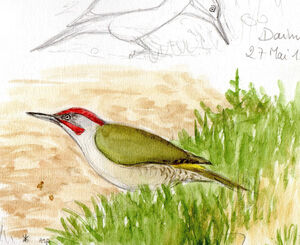Iberian Green Woodpecker
Picus sharpei - Pic de Sharpe
Identification
Formerly considered a subspecies of the Green Woodpecker Picus viridis sharpei, genetic studies show that this form is a species in its own right. Iberian Green Woodpecker differs from its very close Green Woodpecker relative in the absence of black around the eye and unstreaked undertail coverts. The black line around the male's red mustache is very thin, often invisible from a distance. The crown feathers are a different red from those of the Green Woodpecker.
Subspecific information monotypic species
Foreign names
- Pic de Sharpe,
- Pito real ibérico,
- peto-real-ibérico,
- Iberiengrünspecht,
- Iberische Groene Specht,
- Picchio di Sharpe,
- iberisk gröngöling,
- Iberiaspett,
- žlna pyrenejská,
- žluna iberská,
- Iberisk Grønspætte,
- picot verd ibèric,
- dzięcioł iberyjski,
- Дятел Шарпа,
- イベリアオゲラ,
- 伊比利亚绿啄木鸟,
- iberisk gröngöling,
- 伊比利亞綠啄木,
Voice song and call
Habitat
Like the Iberian Green Woodpecker, the Pic de Sharpe needs old trees and cleared grasslands. It is present from the coast (for example around the Etang de Canet in the Pyrenees Orientales) and can reach 3,000m in the Spanish Pyrenees.
Flight
Dietfeeding habits
Reproduction nesting
Most of the singing is most intense in December and January. Laying of the eggs may begin as early as March in the south of its range, but mainly in May in France. Incubation by both parents takes between 14 and 17 days, and young remain in the nest between 24 and 27 days, fed by both parents. After fledging, each parent looks after one part of the brood for almost two months.
Geographic range
The Iberian Green Woodpecker's distribution area is mainly located in the Iberian Peninsula (except for the extreme northwest where it is possible that it is replaced by the Green Woodpecker, studies are needed to verify this situation) and, in France, in a narrow band from the Aude coastline to the mountain forests of the Pyrenees Atlantiques.
The contact zone between the Green Woodpecker and the Iberian Green Woodpecker has been studied in Languedoc-Roussillon. Roughly speaking, it can be said that it forms a strip of a few tens of kilometers wide. Thus, between Béziers and the surroundings of Nîmes, almost all the green woodpeckers have intermediate characteristics (in terms of plumage and genetics) between the Green Woodpecker and the Iberian Green Woodpecker. It is not known whether this situation continues up to the Basque Country.
Threats - protection
IUCN conservation status
concern
in the Wild
threatened
evaluated
In Languedoc-Roussillon, the birds closest to the coast may be threatened by the expansion of urbanization. On the other hand, agricultural abandonment and the increase of scrubs and meadows are of benefit to it. The species does not seem to be threatened.
Sources of information
- IOC World Bird List (v15.1), Gill, F and D Donsker (Eds). 2025-12-07.
- Variation géographique du plumage des pics verts du Languedoc-Roussillon, Olioso G. et Pons J.-M.
- Phylogeography of the Eurasian green woodpecker (Picus viridis)., Pons J.-M., Olioso G., Cruaud C. et Fuchs J.
- Phylogeography and species limits in the green woodpecker complex (Aves: Picidae): multiple Pleistocene refugia and range expansion across Europe and , Perktas U., Barrowclough G. F. et Groth J. G.
- Woodpeckers of the World. The complete guide., Gerard Gorman
- Woodpeckers of Europe, Gerard Gorman
- Avibase, Lepage Denis
- xeno-canto, Sharing bird sounds from around the world,
- HBW Alive,
- Espèces Protégées en France - Oiseaux,
- Birds of the Western Paleartic interactive, Cramp Simmons
Other sources of interest
 Specification sheet created on
29/07/2023 by Georges Olioso
Specification sheet created on
29/07/2023 by Georges OliosoTranslation by AI Oiseaux.net
© 1996-2026 Oiseaux.net
- Accipitriformes
- Aegotheliformes
- Anseriformes
- Apodiformes
- Apterygiformes
- Bucerotiformes
- Caprimulgiformes
- Cariamiformes
- Casuariiformes
- Charadriiformes
- Ciconiiformes
- Coliiformes
- Columbiformes
- Coraciiformes
- Cuculiformes
- Eurypygiformes
- Falconiformes
- Galliformes
- Gaviiformes
- Gruiformes
- Leptosomiformes
- Mesitornithiformes
- Musophagiformes
- Nyctibiiformes
- Opisthocomiformes
- Otidiformes
- Passeriformes
- Pelecaniformes
- Phaethontiformes
- Phoenicopteriformes
- Piciformes
- Podargiformes
- Podicipediformes
- Procellariiformes
- Psittaciformes
- Pterocliformes
- Rheiformes
- Sphenisciformes
- Steatornithiformes
- Strigiformes
- Struthioniformes
- Suliformes
- Tinamiformes
- Trogoniformes






























